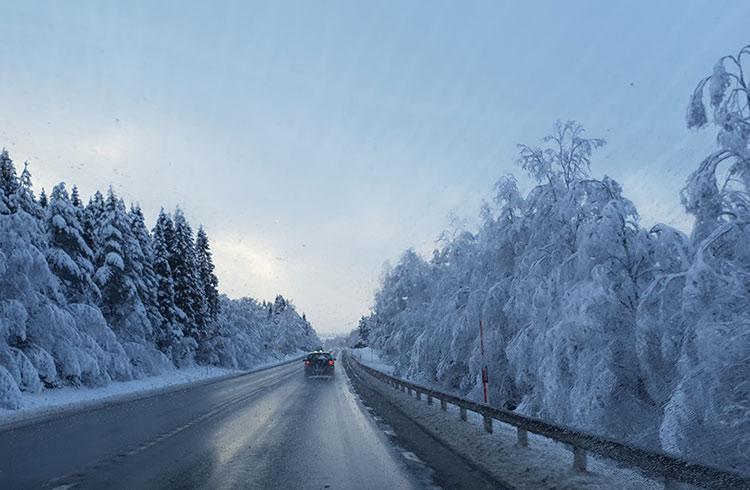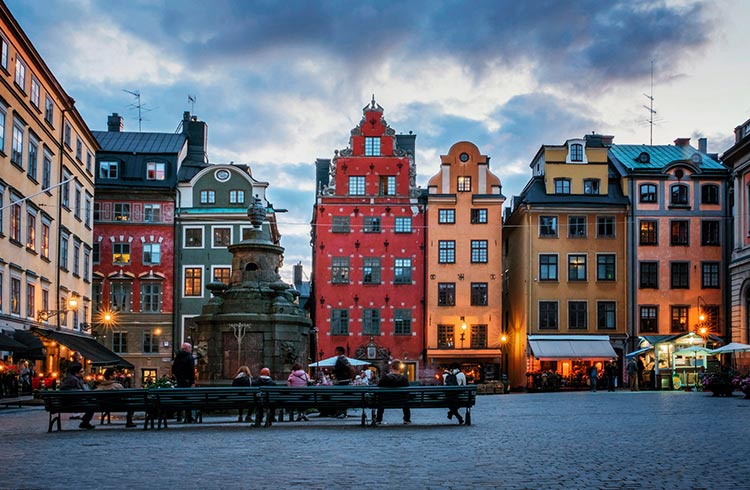Driving in Sweden: How to Stay Safe on a Road Trip
Sweden's road system is generally well maintained and safe, however it takes some preparation and skill to drive during winter. Here's what you need to know to stay safe while driving around the country.
 Photo © Getty Images/Lars Göran Hannler / EyeEm
Photo © Getty Images/Lars Göran Hannler / EyeEm
Is it hard to get a Swedish driver's license?
Getting a driver's license in Sweden is a lengthy, expensive and complicated process. It is such an achievement to finally hold that license, that some Swedes even proudly put it on their CV.
But this long list of theoretical and practical examination does make sure that Swedish drivers are well and truly ready to tackle difficult and dangerous winter conditions by the time they hit the road. Travelers, however, are allowed to drive through Sweden with whatever slapdash qualification we picked up at home.
Roads in Sweden
Luckily the roads in Sweden are excellent. The smooth, slow curves of the highways account for the slippery conditions, while an onslaught of warning signs and speed limits will remind you to drive safely.
Tips to drive safely in Sweden
Sweden is a country of stiff regulation and there are a few rules that you may not be aware of. To save you the embarrassment of injury in one of the world's safest countries, here are a few tips for driving safely in Sweden.
Headlights
Headlights must be used 24 hours a day. Whenever you're driving, your headlights must be on. The most obvious reason is to cater for long, dark winters in the north but, why then, would the rule apply year round?
It becomes obvious as soon as you're on Swedish roads: You are aware of every car around you. Whether it's rounding a blind corner ahead, sliding into your blind spot, cresting a distant hill or clouded out by foggy winter windows, the lights let you know it's there.
All modern cars in Sweden have the lights locked so it's impossible to forget, but the huge cost of car hire in Sweden means many tourists bring one in from outside the country. Flipping on the lights during the day isn't habit for many tourists, so you have to make a special effort to remember not only to turn them on, but to turn them off when you get out. If your battery's flat and the engine doesn't start, neither does the heating. Let that motivate you.
Blood alcohol limit
Sweden has very strict drink driving rules. A single beer can send you over the blood alcohol limit of 0.02, one of the lowest in the western world. The police make frequent spot checks and if you are caught you may very well be prosecuted. Best to stay off the booze if you plan on driving.
Speed limits
The top speed in Sweden is 110km/h on the motorways and there are plenty of cameras to enforce it. However signs announce their presence from way off, which the Swedes have learned to exploit and it's not uncommon to have cars shoot by you at 160km/h or more. For a tourist on unfamiliar roads it's far easier to miss the warnings and find yourself with a hefty fine, so don't push your luck.
Snow tires
Snow tires are mandatory between December 1st and March 31st as they provide more grip and make snow driving safer. Unfortunately the studs and deeper grooves also throw up larger stones and more of them, often cracking the windscreens of cars behind. If this happens to be you, it will soon become apparent that windscreens are not covered under most default car rental insurance so make sure to go for the extensive cover if you're taking a long trip or driving in winter.
If you're not experienced with snow and ice driving it's probably best to stick with Sweden's excellent public transport system in the winter. But if you're determined to get behind the wheel there are a few tips and tricks to remember. The first is to play it easy and even on both the brake and accelerator. Any sudden changes can cause you to lose grip. Set your speed before entering a corner. A change in velocity halfway through a turn could easily throw you into a slide so make sure you gear down or brake well ahead of the curve.
If you do start to skid, you'll retain more grip if all your wheels are moving, so back off the brake and stay away from the accelerator. The rule of thumb is to turn into the skid to try and get your wheels going the same way as you are. If you are traveling up or downhill on an icy road, wiggle the steering wheel back and forth in small movements. This gives the tyres a better chance to grip the road.
If the back of the car ends up sliding, don't panic, just slowly and smoothly turn the wheel the way the rear is moving. Sometimes you might slightly overdo it and the back will lash out in the opposite direction like the tail of an angry cat. I think this why they call it fishtailing. Because cats like fish. Never fear if this happens, just keep gently correcting until you're back in line.
Should you happen to be the first vehicle passing a recent accident, it is compulsory in Sweden to stop and render assistance.
Be aware of wildlife while driving
Sweden is bristling with forests, which make for some fantastic drives but also hide a lot of wildlife. Most of the major highways are fenced off but you'll still have to keep an eye out for deer, moose and reindeer, especially in the north. A collision with any of these would be enough to ruin your day but the moose's uniquely spindly legs and hefty torso mean it could also end up much worse. In a collision the moose's body, which can weigh up to 750kg, is often sent crashing through the car's cabin, to devastating result. So if you'd prefer not to be mashed by a flying moose, make sure to keep these tips in mind.
Driving at night will be the most dangerous because the animals are more active and harder to spot. A moose is often too tall for its eyes to be caught in the headlights, meaning you don't get that telltale glint. There is also a higher risk in spring because the moose are kicking their teenage kids out of home to make room for new bubs. These awkward adolescents are a bit less experienced with roads and a can be a little unpredictable. While moose will generally travel alone, deer are herding creatures so if you manage to spot and miss one, don't assume you're clear of deer.
If you do happen to hit an animal, it is mandatory to report it to police, just like a regular accident. You don't have to wait around to give a witness statement and exchange insurance details but try to take a note of the location so you can pass it on.
Aside from safety tips, there are a few local gems that can make your Swedish sojourn a little easier.
A few final handy tips
Always carry a lighter. The key holes in your car, even the ignition, can sometimes freeze up but a slightly warmed key will cut right through. Make sure not to go overboard though. Too much heat can melt the transponder inside the key, which means you can get it but you won't be going anywhere.
Make sure to pop your wipers forward when you leave the car outside. It will prevent them from freezing up and also make it easier to clean any snow off the windscreen. An identifying marker on your radio aerial can help you pick your white mound from the rest after a big dump of snow.
A bag of salt or sand in the boot can be a great help if you find yourself stuck in the snow. A small shovel is also handy in case you have to dig your car out after a heavy snowfall. In the unlikely case that you do get stuck in the cold for a long time a few extra blankets and some food and water could make all the difference.
Related articles
Simple and flexible travel insurance
You can buy at home or while traveling, and claim online from anywhere in the world. With 150+ adventure activities covered and 24/7 emergency assistance.
Get a quote
No Comments